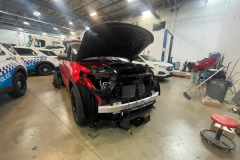From Phil Stenholm:
Another installment about History of Evanston Fire Department
Following a lengthy illness, EFD Chief Albert Hofstetter died on September 24, 1950, at the age of 70, after 49-1/2 years of service with the Evanston Fire Department, including the last 36+ years as Chief Fire Marshal. Though very ill in the weeks prior to his death, Chief Hofstetter still hoped to retire from the EFD on his Golden Anniversary in March 1951. Unfortunately, he didn’t make it that far.
Then just 17 days after the death of Chief Hofstetter, 67-year old 1st Assistant Chief Fire Marshal J. E. Mersch died after suffering a heart attack behind the wheel of his staff car while leading the annual Fire Prevention Week parade up Orrington Avenue. Chief Mersch had served 45 years with the Evanston Fire Department, and was the first Fire Prevention Inspector, serving in that capacity for 22 years after suffering a disabling leg injury in a traffic collision in September 1927. He helped to establish the Fire Prevention Bureau in 1929, and then single-handedly ran it right up until the moment of his death.
The deaths of Chief Hofstetter and Assistant Chief Mersch came just two years after two other long-time chief officers — 46-year veteran Assistant Chief Tom McEnery and 38-year veteran Assistant Chief Carl Windelborn — had retired. The four veteran chiefs had served a combined 178 years with the EFD, an average of more than 44 years per man!
The last major fire to occur during the Hofstetter regime was one that gutted the North Shore Flour Supply Company warehouse at 709 Chicago Ave in April 1950. With the structure located just a couple of hundred feet from Station # 2, Engine Co. 2 was on the scene in about a minute, immediately taking the hydrant next-door to the south, leading out, and attacking the fire through the front door.
Engine Co. 1 and Truck Co. 1 assisted Engine Co. 2, with truckmen laddering the roof and ventilating, while pipemen from Engine Co. 1 grabbed a second line off Engine 2 and followed Engine Co. 2 into the interior. However, Truck Co. 1 was unable to adequately ventilate the reinforced roof, and so the two engine companies working inside had to back-out to avoid being overcome by heat and smoke.
Engine Co. 4, Engine Co. 5, and Truck Co. 2 responded on a second alarm, with Engine Co. 3 changing quarters to Station # 1. The off-duty platoon was called-in to staff the reserve engine at Station # 4 and the reserve truck at Station # 3, and to provide relief for firefighters working at the fire, Nearby Station # 2 was used as a staging area for men from the opposite platoon while they waited for assignments, and as a temporary rest & recovery area for firefighters after being relieved. The blaze was eventually extinguished, but not before a $70,000 loss to the building and its contents.
A few days after the fire, the assistant chiefs who served as the company officers of Truck Co. 1 and Truck Co. 2 scheduled remedial training for members of the two truck companies on the subject of “proper vertical ventilation.” During the course of the training, worsening weathering damage to the aging wooden aerial-ladder on Truck No. 1 was noted. The truck’s ground ladders had been replaced in 1938, but the aerial-ladder, trailer, and tractor were 25-years old.
With Chief Hofstetter on extended medical leave, Assistant Chief Henry Dorband (company officer of Truck Co. 1) was dispatched to meet with Evanston’s mayor and aldermen to explain the problem with the aerial-ladder, and to offer possible solutions:
1. Replace the wooden aerial-ladder with a metal aerial-ladder (estimated cost: $15,000);
2. Replace both the aerial-ladder and the trailer (estimated cost: $25,000);
3. Replace the tractor, trailer, and aerial-ladder (estimated cost: $35,000).
The city council opted for choice # 3, and the city advertised for bids to supply a tractor-drawn aerial-ladder truck, with specifications that included an 85-foot metal aerial ladder, water-proof equipment compartments on the trailer, and a canopy cab with additional rear-facing bench seating for four behind the cab.
In what was something of a surprise, Peter Pirsch & Sons of Kenosha, Wisconsin, came in with the low-bid and was awarded the contract. With an estimated delivery date of August 1951, the EFD’s new TDA would be the first fire apparatus purchased by the City of Evanston from a manufacturer not named Seagrave since 1911.
Over the years, Evanston had been one of Seagrave’s best customers, spending upwards of $135,000 between 1917-49 to purchase a total of eight pumpers, three ladder trucks, and a tractor, plus major repairs to damaged rigs in 1927 and 1928, and a rebuild of one of the 1917 pumpers in 1930. However, by 1950 Seagrave was inundated with post-war apparatus orders that sometimes resulted in delivery dates as long as two years, and it was losing bids it would have won in the past.





































